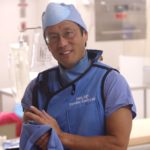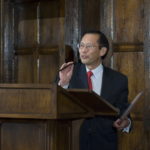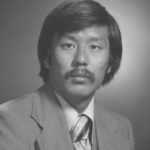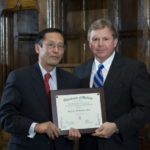Rick Nishimura, M.D. — Q&A with a Teacher of the Year perennial
 From a glance at his CV, you can tell Rick Nishimura, M.D. (I ’80, CV ’83), loves teaching. The list of honors and awards fills three pages, and most of the awards pertain to teaching (see list at end of story). He began collecting these awards in 1985 and hasn’t slowed down. He’s in the Mayo Clinic School of Graduate Medical Education Teacher of the Year Hall of Fame. He received one award — Outstanding Cardiovascular Diseases Teacher, Cardiovascular Diseases Training Program, Mayo Clinic School of Graduate Medical Education — for so many sequential years that it was decided to withdraw his name from future nomination and name the award for him. Beginning in 2016, awardees now receive the Established Nishimura Outstanding Cardiovascular Teacher Award.
From a glance at his CV, you can tell Rick Nishimura, M.D. (I ’80, CV ’83), loves teaching. The list of honors and awards fills three pages, and most of the awards pertain to teaching (see list at end of story). He began collecting these awards in 1985 and hasn’t slowed down. He’s in the Mayo Clinic School of Graduate Medical Education Teacher of the Year Hall of Fame. He received one award — Outstanding Cardiovascular Diseases Teacher, Cardiovascular Diseases Training Program, Mayo Clinic School of Graduate Medical Education — for so many sequential years that it was decided to withdraw his name from future nomination and name the award for him. Beginning in 2016, awardees now receive the Established Nishimura Outstanding Cardiovascular Teacher Award.
Dr. Nishimura also has been lauded for clinical care and research. He received the Plummer Award for a Distinguished Clinician in 1996, the Mayo Clinic Distinguished Clinician Award in 2002, and a named professorship — the Judd and Mary Morris Leighton Professorship in Cardiovascular Diseases — in 2001. But he says being recognized for his education efforts is the greatest honor he can receive.
“A lot of extra effort goes into teaching, but it’s one of the reasons I’m at Mayo Clinic,” says Dr. Nishimura. “To be recognized for it, especially by your own fellows and residents, is a real pleasure.”
Dr. Nishimura is chair of the Division of Structural Heart Disease in the Department of Cardiovascular Medicine and a professor of medicine in the Mayo Clinic College of Medicine and Science. He completed a residency in internal medicine and fellowship in cardiovascular diseases at Mayo Clinic School of Graduate Medical Education and joined the staff in 1983. He has served as a member and chair of multiple education committees of the American College of Cardiology in addition to other professional organization roles. He has been active in the Mayo Clinic education institutional committees and cardiovascular divisional education roles.
Until the last year, he had instructed first-year Mayo Clinic College of Medicine students for 30 years. “It was a highlight of my year to be with those young kids, with their innocence and inquisitiveness,” he says. “It was time to let our younger teachers fill that role, but I miss it.”
For many years, Dr. Nishimura led the hospital service with internal medicine residents, providing them with a foundational knowledge of cardiology. Today his teaching focuses on cardiovascular fellows. “They already have a good base of knowledge,” he says. “I teach them clinical applications and decision-making using the available tools and imaging modalities as well as complex hemodynamics in the cath lab.”
How do you know when you’ve done a good job teaching?
I can see it in their eyes. I see the lightbulb go off. It’s evident because their whole facial expression changes.
 What’s most rewarding about teaching?
What’s most rewarding about teaching?
Knowledge is readily available with smart phones and the intranet and tools such as AskMayoExpert. When you get older like me, you have accumulated wisdom that isn’t necessarily in the textbooks — being able to diagnose a complex patient by putting together the pieces of the puzzle, which includes information obtained in direct interaction with the patient through the history and physical examination.
The real art of teaching is helping trainees put it all together. Medicine is an “art,” not a science. When they’ve mastered the art of medicine, they’re able to combine the individual patient data and test results with the most updated medical knowledge, and convey their proposed pathway to patients and their families, winning their trust. It’s a real privilege to be in that situation — as a trusted source of help.
It’s rewarding when trainees go out on their own and succeed. I have learned as much from my students as they’ve learned from me.
 What’s your teaching style?
What’s your teaching style?
The Socratic method. I never tell trainees the answers. I keep asking them questions, and I ask them to reflect on what they’re learned at the end of the day.
I’m probably demanding. Those who want to learn come back day after day.
One of our responsibilities as educators is to teach others how to teach. I run a cardiovascular board review course, and we’ve incorporated young, enthusiastic faculty into it and provided them with insights about how to teach.
Have students changed through the years?
Increasingly, they come to Mayo Clinic with more compassion and ability to be team players, as opposed to the “old-fashioned, isolated physician.” The personal, human touch is more pronounced in today’s trainees.
As “digital natives,” they learn differently with all the electronic tools and knowledge sources available today. Thus, they don’t need to obtain the actual knowledge from their teachers and mentors. What they need is the application of clinical judgment using the knowledge.
Who are your teaching role models?
The ones who stood out the most were Udaya Prakash, M.D. (I ’73, THD ’77), Edward Rosenow III, M.D. (I ’65), John Joyce, M.D. (I ’63), and A. Jamil Tajik, M.D. (I ’70, CV ’73). They all have a passion for teaching and are very good at it. I like to watch people teach and lecture and apply the best of what they do to my own teaching.
- Teacher of the Year, Fellows Association, Mayo Clinic School of Graduate Medical Education — 14 times
- Teacher of the Year Hall of Fame, Fellows Association, Mayo Clinic School of Graduate Medical Education Medicine
- Mayo Clinic Distinguished Educator Award — 2007
- Outstanding Cardiovascular Diseases Teacher, Cardiovascular Diseases Training Program, Mayo Clinic School of Graduate Medical Education — 27 times
- Department of Medicine Lifetime Achievement Award for Outstanding Contributions in Medical Education — 2009
- American College of Cardiology Gifted Teacher Award — 2006
- American Heart Association Laennec Clinician Educator Award — 2007
- Outstanding Faculty, Mayo Clinic School of Continuous Professional Development — 2 times
- Outstanding Program Director, Mayo Clinic School of Continuous Professional Development — 2001
- Outstanding Course Director, Mayo Clinic School of Continuous Professional Development — 2010
Student comments
“Dr. Nishimura is a role model for all the cardiology fellows at Mayo Clinic and around the country. He continuously challenges us to look beyond a hemodynamic or clinical finding and go to the next level of thinking. He has the incredible ability to determine a learner’s level of knowledge and identify gaps in that knowledge. He goes about it in the perfect way — pushing you without making you feel like you are inadequate.”
“Dr. Nishimura will always give extra time for teaching and makes sure you understand the concept clearly. He breaks down complex cardiovascular issues into simple steps so everybody can understand it.”
“Dr. Nishimura is an excellent mentor, great teacher, and respectful and enthusiastic. He not only teaches you clinical medicine but also empathy, communication, patient interaction and how to be the best doctor for your patient. Despite his prominence, he is always approachable and receptive.”
“Dr. Nishimura’s passion for teaching is well recognized by the cardiovascular fellows. He basically has a fellow glued to his hip, eagerly soaking up the knowledge he shares in the clinic, in the cath lab and at Thursday afternoon lectures.”
“How many times have I heard, ‘Well, I guess you should read up on that’? I always walk away from his conferences recognizing how much I have to learn. My head often hurts after a clinic day with Dr. Nishimura from all the thinking I’ve done. He has a knack for taking a simple physical exam finding and turning it into a teachable moment — one that will not be forgotten.”
“His bedside manner is something we all hope to emulate one day. Dr. Nishimura is the best of the best.”

